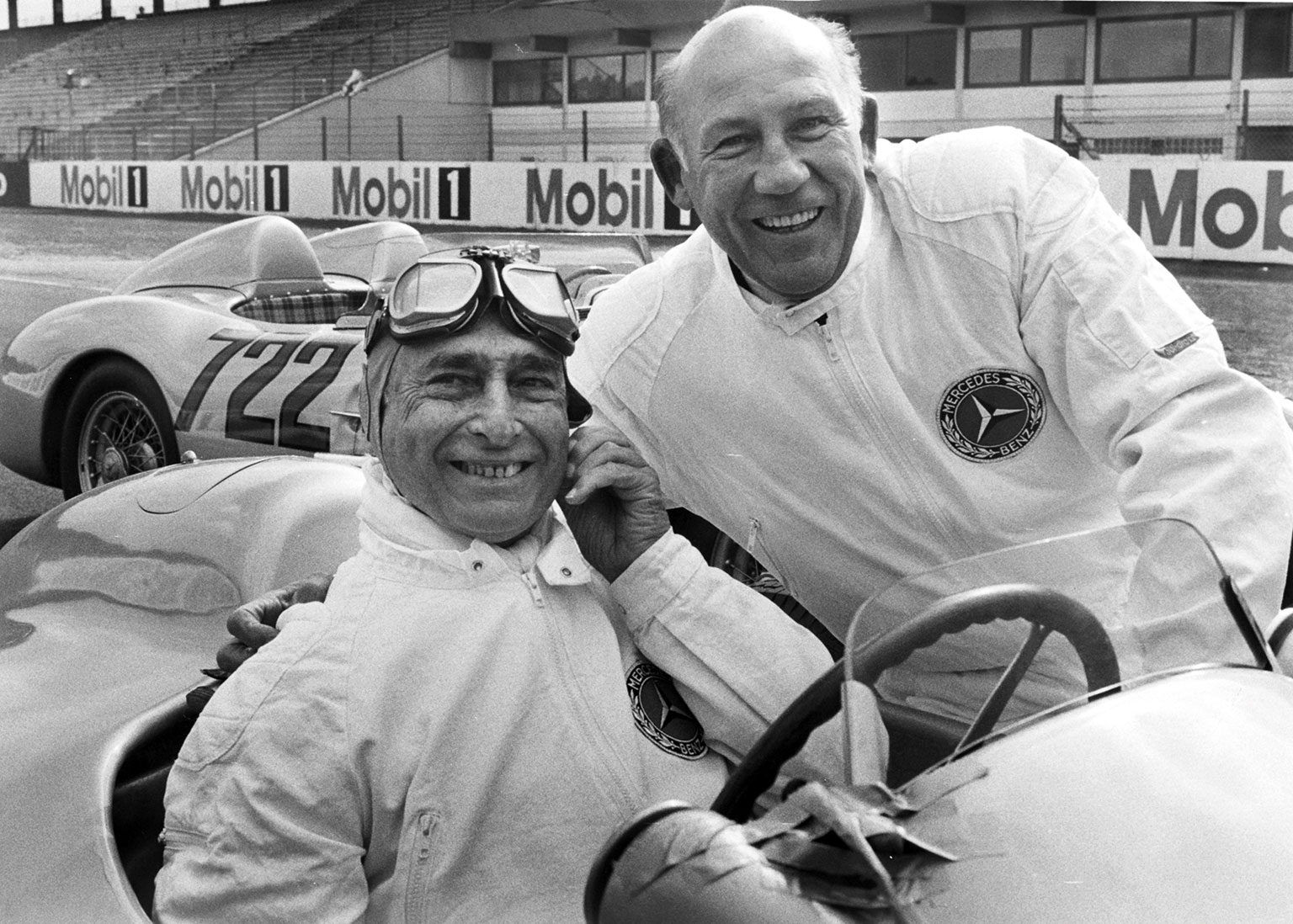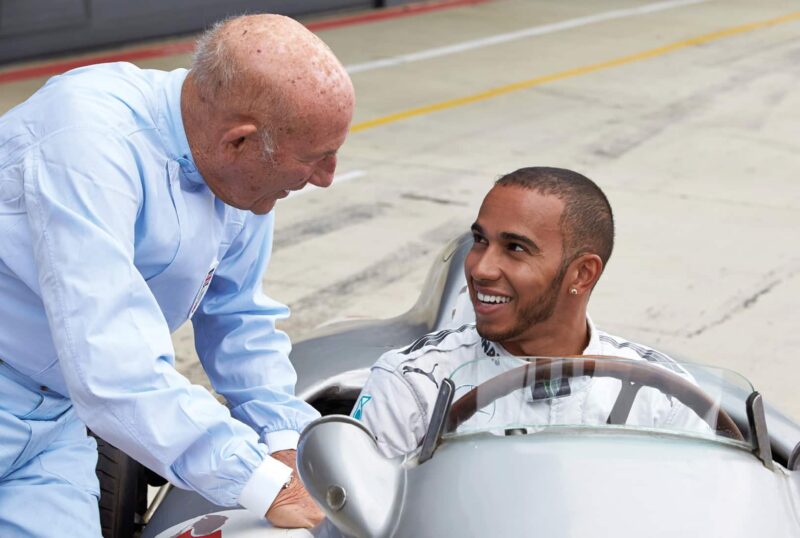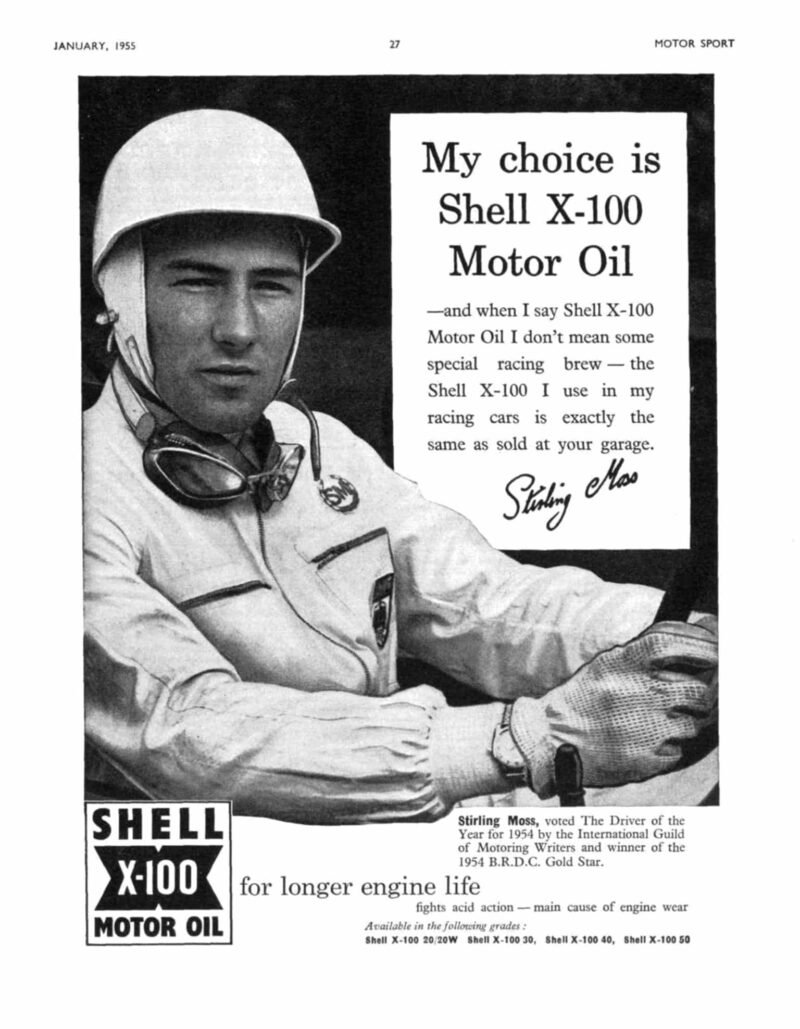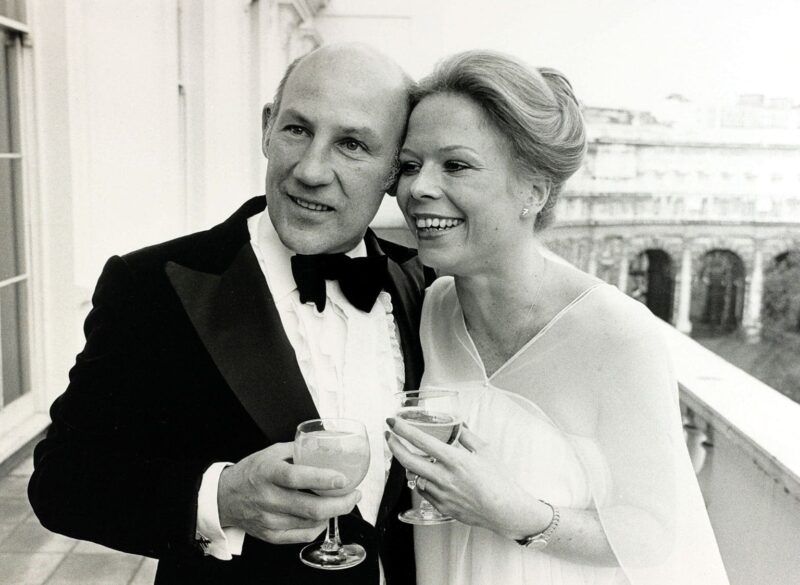The rise of Sir Stirling
His success and legend is known by all, as Moss transcended his sport. Doug Nye shares the inside view on what drove the titan of racing

Moss and Fangio reunited in 1991
Much of Stirling Moss’s story has been recorded within the pages of this magazine. From boyhood, he was one of its avid readers, a supporter and sometime critic. At 25, he put in perhaps the greatest winning drive in motor-sporting history, in the 1955 Mille Miglia, and he had our mutual friend and Motor Sport Continental Correspondent Denis Jenkinson right
there in the cockpit beside him. DSJ was reading painstakingly prepared route notes and making the hand signals which, if any had been incorrect, could have cost both their lives.
That bald fact demonstrates the difference in the racing environment through which Stirling lived, and so excelled. Topline motor sport from the 1940s through the 1960s was a world of the quick, and the dead. Racing risks were immense. He was one of the many who stepped up, stared down the gun barrel and then ultimately prevailed.
And while for much of his frontline career he was probably the most naturally gifted, and the best, for the last four years of his career he was undoubtedly and demonstrably both. Ignore that modern-era twaddle about never winning the World Championship. Truth was that although it hurt him to finish second for four consecutive years, it was a title he never needed. Every rival knew he was ‘The Man’. Beat Moss and you were somebody…

Lewis Hamilton and Moss always got on well, and together shared similar racing values
Getty
For any child of the 1940s or early ’50s who grew up as a motor racing enthusiast, the name Stirling Moss simply became part of our lives. He has remained so ever since. For anyone around the world who wasn’t necessarily a racing enthusiast, but recognised international celebrities, Moss was surely one of them. That didn’t happen by accident. His racing success made headlines worldwide because he was truly an early global player. And he worked upon promotion – first for his sport, then himself. ‘Stirling Moss smokes Craven-A’ – and ‘Stirling Moss says ‘every driver should fit the Trico automatic windscreen washer’. In newspapers and magazines, on radio, the big screen, TV, and books – Moss the Motor Racer was absolutely everywhere.
The British press had gushed about preceding ‘Speed Kings’ – Henry Segrave, ‘Tim’ Birkin, Malcolm Campbell – perhaps strangely, less so about Dick Seaman, even in death. But Stirling’s achievements would exceed them all. His fame infused the fabric of British life for decades beyond the 14 mainstream years he raced – because he worked at it.
He was a truly electric man, vivid, bursting with energy. He was never still. His concentration span could be famously brief, yet when fully focused he was laser-beam intense, and his stamina legendary. His long-held motto became ‘Motion is Tranquility’. In that case for most of his life, he was hyper-tranquil. His lifetime mileage by road, air and sea is almost matchless.
He raced anything and everything, and he’d extract everything a car had to offer, at home, throughout Europe, in North America, South America, South Africa, Australia, New Zealand. In later years, post-frontline retirement, he’d appear in Asia. One day when I was taking the mickey, he did admit “OK, so I never quite cracked Antarctica…” – but among a global public he proved hugely popular, and always proudly British.
He was a born businessman and absolutely adored anything that paid. Driving a Sunbeam-Talbot to finish second in the 1952 Monte Carlo Rally – “Fifty quid fee, boy!” – three consecutive Coupes des Alpes for one of only two Coupes d’Or (Gold Cups) by that time ever awarded – “Another fifty quid boy!”. He raced to win, but also to live – and what a golden life he lived. He was one of the first English-speaking utterly professional racing drivers. Many car owners, entrants and team-mates found him, in his pomp, infinitely demanding, restlessly seeking an extra edge. Jenks once assured me “Stirling had the talent to win in anything, but he’d always try to find that little extra car advantage by trying something new, and it often let him down… If he’d played safe, he’d still have won”. But back in Stirling’s time cars were not as reliable as today. So he earned a reputation as a car breaker, yet the latest tweak was so often unproven he wasn’t always to blame.

Stirling Moss stars in a Shell advert, from January 1955. Below: on his wedding day with wife Susie
In truth, playing safe just wasn’t his way. He revered Fangio but would admit “The one thing I never agreed with was his saying ‘Always drive to win at the slowest possible speed’ – just to reach the finish. To me, that wasn’t racing. I wanted to race – to go out there, get stuck in and have a right old tear up!”.
Does that remind you of someone, a British six-time World Champion? Moss and Lewis had much in common… and when they spent time together they got on well…
So what else powered his ambition? Father Alfred ran a large and lucrative dental business, with surgeries often in the poorer parts of London. Moss admitted he owed both his parents – Indy driver Alfred and trials driver mum Aileen – hugely for their early support and investment. But he also told me that at school, with a name like his, he’d experienced adolescent anti-semitism… “‘Jew boy’, ‘yid’, that sort of thing – they might have been bigger than me, but it made me think, ‘OK, I’ll show you!’ ”.
And boy, so he did.
Stirling was naturally athletic and fit, and after spilling a burning paraffin stove over himself as a kid, he had a high pain threshold. It stood him in good stead when he broke his back in a crash during Belgian Grand Prix practice in 1960, yet began racing again just seven weeks later…
After his career-ending Easter Monday Goodwood crash – when for weeks after we feared he would not survive – he judged that his skills had been diminished, and, still only 32 years old, he began building himself a fresh career as the world’s first professional retired racing driver and excelled in doing so.
For the past 40 years, he would give enormous credit to his adored and utterly inseparable soulmate wife Susie, as he said in his hilarious, yet moving, speech at their 25th wedding anniversary celebration: “If it wasn’t for Susie, I’d still be the way I used to be…” – at which the large majority of his lifelong friends just cracked up. They all certainly remembered…

With his wife, Lady Susie
Getty
Sir Stirling Moss, OBE, was a superstar whose image as a world-class sportsman transcended the confined sport in which he had so excelled. The country he loved all his life has had very few sporting icons who have ever reigned supreme as absolutely the world’s best in their own particular sphere. He was one.
To me, for many years, he had simply been The Greatest Living Englishman. But there’s more than that. Stirling was just a thoroughly good bloke.

